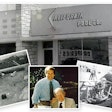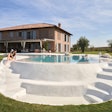What memorable company or product doesn't start its own identity with a successful brand. Think Coke and Ford. Your pool and spa dealership is no different than any other business, according to Ken DeLor, president of The DeLor Group, a corporate and product brand-identity firm in Louisville, Ky. "The best brands create differentiation, are profoundly clear, have an 'attitude' and effectively deliver the brand experience."
MORE THAN AN IDENTITY
"A brand is the promise and personality that you present to potential and existing clients," DeLor says. "The promise is who you are, what you do, your strengths and your differentiators. The personality is the visual attitude, style and feeling, how you relate to your staff and [customers], and why they continue to come back to you."
Simply put, says Sonia Greteman, president of The Greteman Group, a design firm in Wichita, Ks., "Branding is the heart and soul of your business."
It's not just a look or logo, or even your store's features and benefits. As Deanna Harms, vice president of The Greteman Group explains it, a brand is the "mind-share" that you occupy with your customers through every aspect of your business that touches them — from your store interior and exterior design and phone greeting to your letterhead, Web site, advertising and direct mail pieces.
THE WHYS AND HOWS OF BRANDING
If you don't brand your pool and spa dealership, your competition will do it for you. Don't give them the opportunity. The spa and pool industry yields a diversity of retail approaches, with each retailer claiming their specialties in store atmosphere, products and customer service. Therefore, it's important to create a clear position about who you are, what you sell and which services you provide, so your store brand can influence the way customers perceive you.
Sit down with your management team and do some hard searching about what you want to project to your existing and potential customers, as well as vendors. Then follow these 10 steps toward a successful brand identity.
1. Ask yourself who you are. From your own vantage point, consider your business's strengths and weaknesses. What do you see yourself as?
What makes you unique?
2. Determine where you fit. Examine how your business has positioned itself in the marketplace. How does or doesn't it differ from your competition?
3. Gather others' perceptions. Through casual conversation and/or formal questionnaires, ask your staff, customers, vendors and investors how they perceive your business.
4. Reality check. Consider how others view your business in relation to how you would like to be perceived by them. Then consider how you can bridge the gap.
5. Research the terrain. Learn what's out there. Explore the opportunities for, and threats to, your business. How can you attract the former and avoid the latter to project a better image of your store to others?
6. Decide on a direction. With a clear view of where your business stands, determine what you want your brand to say about your business.
7. Create the look and feel. Keeping others' perceptions and your own goals in mind, build a unique brand through color, type style, logo, images, words and a store motto or tag line.
8. Determine a budget. Decide how much you can afford to spend to execute your brand, both in terms of money and time. Set financial budgets and timetables, and stick to them.
9. Bring your brand to life. Make it integrated and keep it consistent throughout every aspect that comes into contact with customers and vendors — from your visual communication elements (store logo, signage and stationery, for example) to your marketing strategy, advertising and customer relations.
10. Draw attention to yourself. Remember, your customers are used to seeing you in a certain way. So, herald your new or rejuvenated brand with direct-mail announcements, bigger-than-normal advertising, or even an in-store celebratory event.
KEEP IT FRESH
"Continually look for different ways to express your brand," says DeLor. "There are lots of ways to do that, especially if the brand has room to grow and expand."
As your business evolves, you'll find that you'll want to redefine your retail direction, reclarifying what you do and how you communicate that to the customers you target. You'll know that your brand is working successfully when you attract the customers you want.
Along with building a stronger customer base, an effective brand embodies your company's true personality and spirit. It also exudes creativity and integrity, and regularly expresses itself consistently along all avenues of communication with your customers and vendors. When that happens, you've got a vehicle that can only drive your business further in the direction you want it to go.
Brand Building
- Commit yourself. Decide that developing your brand is important and promise to apply yourself to the task.
- Dedicate the time and resources. It's easy when you're already facing other expenses and commitments. But don't let yourself get in your own way.
- Follow a disciplined process. Draw up a schedule of goals, determine a reasonable budget, and track your hours and expenses. Prove to yourself later that the time and money you will have invested are worth it.
- Think it through. Research the marketplace, study the brands of your competitors (as well as those businesses outside the industry), interview customers and vendors, and define your strategy. Then write an indepth plan.
- Determine how you stand out. When you know what makes your store unique, you can better differentiate yourself from the competition and develop the best brand to attract the customers you want.
- Make it memorable. Don't overdo the look of your brand. Clear and simple ones communicate more powerfully than those that are too bold, trendy or gaudy.
- Be consistent and thorough. So that no matter how your customers experience you, they'll receive the same message.
- Leave room to evolve. Create a brand that will grow with your business and the industry.
- Introduce your brand with flair. Throw a party for customers and vendors and tout your brand in the media. Make a splash so customers will recognize, remember and respond.
- Stay Top of Mind. Continually remind customers why they should return with repeated advertising, direct mail and instore events.






































